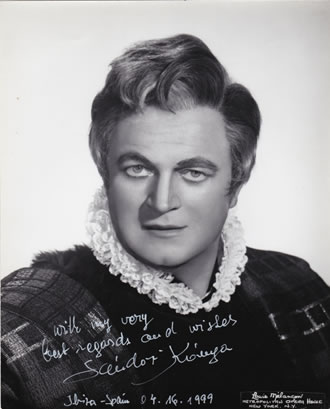 (courtesy Charles Mintzer coll.)
(courtesy Charles Mintzer coll.)Introduction
SANDOR KONYA AND HIS RECORDINGS
by Jan Neckers
 (courtesy Charles Mintzer coll.)
(courtesy Charles Mintzer coll.)
Introduction
In 1962 I went to a Teacher's Training College in the small Flemish town of Lier (Ernest van Dijck died in a village in the vicinity) In my class there was a lot of interest in all kinds of culture and nobody found it strange that opera-singers were a passion for me. At the end of the first trimester my fellow students could all say Franco Corelli-Carlo Bergonzi-Sandor Konya whom at that time I thought the three greatest tenors around. Strange though it may sound now some of them knew Konya by name while the two others were completely unknown to non-opera-lovers. In those days there still didn't exist a ghetto-radio exclusively devoted to classical music, so apart from the inevitable Ankas and Presleys and French chansonniers one could still hear real singers from time to time. Soccer matches were uniformly played on Sunday afternoons and a particular favourite of the anchor-man was 'Du bist die Welt fuer mich', Richard Tauber's most memorable composition and freshly recorded by that new exciting tenor Sandor Konya.
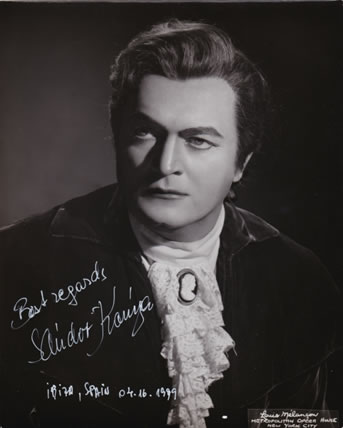
In those days operetta in Western Europe was still immensely popular and every radio-station would devote quite a lot of time to operetta-recordings which were considered light music and miles apart from classical music. Operetta was not quite taken seriously and one looked somewhat suspiciously at Legge's complete operetta-recordings or Decca's Giuditta with Gueden and Kmennt. Happily (as we fools thought) these recordings were soon broken into Highlights and 45 EPs. As records were still tremendously expensive there was quite a demand for Querschnitte (=Highlights) on 45 or MP. The ideal seemed to be the recording of one LP with four operettas on it, a recording that then could be sold as four EPs or 2 MPs as well.
The German labels all had their own artists. EMI had Rudolf Schock and Erika Koeth and would later take on Fritz Wunderlich. Heinz Hoppe and Anneliese Rothenberger sang on Telefunken. Polydor (the “light” branch of DGG) had Peter Anders and Anny Schlemm. When Anders died Polydor looked around and found Sandor Konya. Now the strange thing is that some of these tenors would never sing one single operetta on stage (maybe with the exception of Die Fledermaus) but that they quickly learned their roles for the recording or for a radio-highlight-selection which was sometimes put on record. Wunderlich never sang an operetta on stage and as far as I know neither did Konya.
German television would sometimes produce an operetta which would then do the rounds of other European countries though often an actor would play the role and mimic the arias. Somewhere in the vaults of German Public TV there rests a complete Lehar 'Paganini' with Sandor Konya in the title role and I still remember my disillusionment when I watched it and it became immediately clear the tenor was not acting himself.
KONYA IN OPERETTA
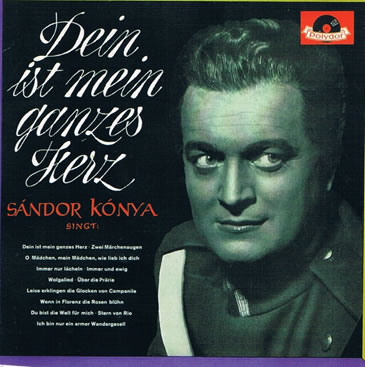
I collected everything Konya recorded. There were the selections of Das Land des Laechelns, Ein Walzertraum, Gasparone, Der Bettelstudent, Victoria und Ihr Husar, Die Fledermaus, Der Zigeunerbaron and Wiener Blut. Most of these recordings were transferred on Philips-CDs and are available at the German branch of Amazon. Not all of those recordings are to be advised unconditionally. Konya's partners were never on a par with Schock's or Hoppe's sopranos. Usually there was the rather strident Herta Talmar, occasionally replaced by the more refined Ingeborg Hallstein. The main drawback however is the highlights-format. When we now listen to the too few complete recordings on EMI with Nicolai Gedda, recorded at the end of the sixties, it strikes us how little difference there is with opera. In German operetta no buffo tenor can sing the title-role. The ensembles and concertatos are not all easily to master and often work of genius.
In the Konya-recordings the ensembles are often heavily cut and the finer points of the score are completely lost. Most of the big tunes are recorded complete though here too often shorn of some measures of music. Moreover Konya often sings rather straight on without too much diversification or caressing of phrases; just a routine job done quickly to earn a few marks. He is far better in a spectacular operetta-recital with some very enthusiastic swaggering singing, especially in Kalman's Die Zirkusprinzessin, Kuenneke's Der Vetter aus Dingsda plus of course Tauber's Der singende Traum. He also recorded several (mostly 45 T.) records with popular German songs. Nothing of this all was transferred on CD, a real loss.
OPERA RECORDINGS
Konya did most of his recording on DGG. After his triumphs as Lohengrin in 1958 at Bayreuth he recorded some solos from Lohengrin and Die Meistersinger. DGG also started out recording highlights in German language of operas from the French, Italian and German repertoire. They took a few arias from those sessions and put them on an MP together with the Wagner-arias.
When Konya's reputation blossomed they once more took the Wagner-arias, added some arias recorded for 45 T. and thus came into existence his first LP: a somewhat hybrid production with some Italian arias sung in German. Anyway that was the LP that made his reputation outside the German-language countries and here too we still wait for a transfer.
The list of the selections for the German market is long: Aida (with Davy and Hotter; there is an Hungarian language selection too with Dery and Komlossy)), Il Trovatore (with Davy), Nabucco (with Stewart and Lear), Pagliacci, Cavalleria (with Davy), The Tales of Hoffmann (with Dobbs and Stewart), Der Evangelimann, Carmen and My Fair Lady. These recordings form the bulk too of Gloria Davy's recorded output.
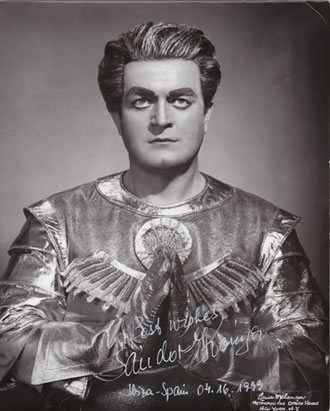 (Lohengrin, courtesy Charles Mintzer coll.)
(Lohengrin, courtesy Charles Mintzer coll.)
With the war memories retreating and 'das Wirtschaftswunder' restoring Germany to economic prosperity, DGG decided to go all the way and record complete operas, though still in German. In 1960 alone Konya recorded La Boheme with a formidable cast (Lorengar, Streich, Fischer-Dieskau), Tosca (Woytowicz, Borg) and Butterfly (Schlemm); the last recording still waiting waiting for a transfer. These recordings show Konya's voice at his most fresh and limpid.
That same year DGG started its collaboration with La Scala and there would be no place in it for Konya as he was still mainly considered to be a German tenor. DGG preferred real Italian names like Poggi and Raimondi until they at last struck gold with Carlo Bergonzi. Nevertheless Konya sold quite a lot of records and in 1962 there appeared his most famous recording, an all-Puccini recital in Italian that has been transfered on CD.
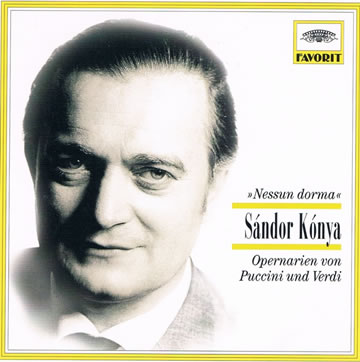 <
<
By that time his career was blossoming. Konya had made his American debut at San Francisco in 1960 (Fanciulla with Gobbi and Kirsten) and he first bowed at the Met in October 1961. He would stay there for thirteen years and sing 287 performances. And now a very strange thing happened. While he became famous in the US his recording career went down hill.
At Polydor his place was quickly taken by Fritz Wunderlich who recorded one LP after another with popular ditties. And in the age of Corelli-Bergonzi-Tucker and that perennial Decca-favourite Del Monaco there was no room for a brilliant but slightly less-talented tenor for recordings of the Italian repertoire. His greatest asset at the Met, his ability to sing important parts in the Italian, the French and the German repertoire, brought his recording career down because in Germany there came an end to the policy of recording selections in German and he was deemed not good enough to sing the heroes in the original-language-recordings.
There was only an Alfred in RCA's 'Die Fledermaus' and the same firm's 'Lohengrin'( available on CD ) where Leontyne Price withdrew at the last moment and was replaced by Lucine Amara and where Rita Gorr shrieks her head off. He also recorded an almost obscure recital of Verdi and Wagner songs.
LIVE RECORDINGS
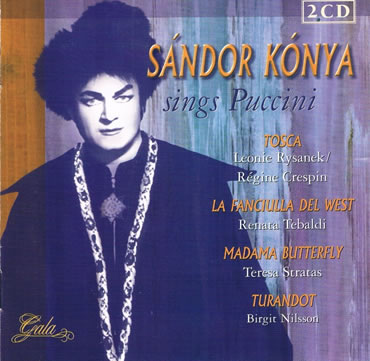
Though there are quite a lot of broadcasts circling around on cassette, tape or CD-R there is little available on commercial live-recordings: a 1958 Froh from the Bayreuther Festspiele and a 1967 Walther von Stolzing.
Many collectors will be able to live their lives without most of his Met-performances but the magnificent 1969-Bavarian Radio recording of Smetana's Dalibor (even though in German) is a real relief after the less than Italianate Czech-recordings and should urgently find its way to CD. Moreover Kubelik conducts a wonderful cast with Weathers, Morison, Nienstedt and Crass.
After Konya's career ended there came a double LP on Melodram (Rigoletto, Ballo, Chenier, Fedora, Manon Lescaut, Bohème, Butterfly, Lucia, Contes, Hollaender, Lohengrin and Parsifal), later on followed on the same firm by a double CD (Contes, Lucia, Lohengrin, Don Carlo, Tosca). Both albums were snatched up amazingly quick by lovers of his voice and are very difficult to find.
EPILOGUE
Konya's reputation has suffered a lot from this neglect. In the early sixties he was considered to be a more important singer than Fritz Wunderlich whose career in those days was restricted to German-speaking countries. The German tenor was quite jealous of Konya and once somewhat bitterly remarked in an interview that there are some tenors with real high C's who have less success than those with only a B that however gives the impression of a formidable C.
Konya whose best and strongest high note was an A and could indeed give that false impression as he had a rather high lying tessitura in the great Hungarian tradition (cfr. Ilosfalvy, Symandi, Gafni, Nagy). His lean voice had an immediately recognizable lovely Italianate timbre and an inbuilt tear which he exploited shamelessly in his Italian roles. But while his American engagements made him a rich man, his recording career came to an end. Wunderlich would be quite amazed to see how many of his recordings are now on the market and how few there are of his rival.
Click here to read more about Sandor Konya releases